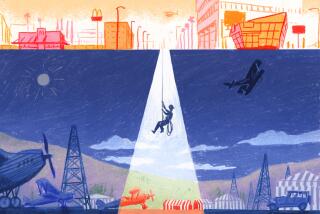Hopes for Restoring P-40 Fighter Take Wing at Torrance Airport : History: A fan of the Flying Tigers’ fabled aircraft laments the fact that none of the World War II planes survive, except as wreckage.
- Share via
To a child growing up in wartime Los Angeles, the world--with its wailing sirens, blackouts, and palpable fears of invasion--was a frightening place. Torrance resident Kent Lentz remembers that when he was 6, a John Wayne film called “The Flying Tigers” temporarily eased his anxiety about World War II, holding out hope that the United States would win what was then a losing fight.
The 1942 movie chronicled the exploits of a band of maverick American fighter pilots battling the Japanese over the skies of South China. For Lentz, 54, the film’s most memorable feature was the aircraft the American pilots flew--the P-40 Tomahawk.
Although Lentz’s childhood memories have endured, the plane glorified in film did not. Quickly made obsolete by technological advances, the P-40 Tomahawks--which historians credit with the first U.S. kills at Pearl Harbor in World War II--were phased out by the summer of 1942. Today, none of the 524 P-40 Tomahawks used by the U.S. Army Air Corps exist other than as wartime wreckage.
But Lentz is working to resurrect the plane. He is president of the Curtiss-Wright Historical Assn., a nonprofit group in Torrance dedicated to restoring a P-40 Tomahawk. The group has targeted Aug. 15, 1995--the 50th anniversary of V-J Day--to showcase the plane, which will not be able to fly.
“I’ll be ready to die when that airplane is finished,” said Lentz, who admits that his romance of boyhood has become an obsession of manhood. “Until then, I’m on a divine mission from God.”
Lentz’s near-religious zeal for the project is driven by more than an appreciation for the P-40 Tomahawk’s history. The work, he hopes, will help underscore to the nation two crucial points: Do not underestimate adversaries and be prepared.
The Flying Tigers and their planes also provided another lesson, Lentz says: Don’t underestimate Americans. “The common myth in Japanese culture at that time was that Americans were lazy, decadent--not fighters. Well, they got a real serious lesson,” he said. The unit, formally called the American Volunteer Group, disbanded after seven months. But it amassed one of the most impressive kill/loss ratios in World War II. Although outnumbered in virtually all its air battles, the pilots shot down 299 enemy planes, while losing only four.
“It was the top-of-the-line fighter at the time,” said Charles Older, a P-40 Tomahawk pilot with the Flying Tigers who is also a member of the nonprofit group. “ . . . It was a rugged airplane. I think everyone that flew it was confident it would get you home unless something drastic happened.”
Older distinguished himself not only as a crack pilot, logging 18 kills during the war--10 of them with the Flying Tigers--but also later as a Superior Court judge when he presided over the Charles Manson murder case. He serves on the historical association’s board of directors.
The group estimates the expense of rolling out a restored P-40 at about $300,000. Lentz and another founding member of the group, Mike Fortner of Carson, have collected about $80,000 in donations, but about $60,000 of that is their own money.
Originally, the group wanted to return a restored plane to flying condition, but opted against it. For starters, the effort would send costs soaring to about $1 million. And more important, Lentz said, the remote chance of ever losing such a historically significant plane was considered too great a risk by the group.
Despite a funding shortage, Lentz expects the organization to make its 1995 deadline. The group, most of whose 90 members live in the South Bay, received a boost in November when the Torrance Airport Commission agreed to rent it a hangar at a low rate, Lentz said.
Inside the hangar, restoration work has begun. A skeletal frame of wood and some original parts of the P-40 Tomahwak is already assembled. Obtaining--even finding--original parts has been a struggle.
What parts the group has been able to secure have come from the salvaged pieces of three planes that crashed in California’s High Sierra and near Pearl Harbor. Lentz estimated that when the project is completed, about 20% of the aircraft will be original parts.
With a Tomahawk exhibit saved for posterity, Lentz said the group will turn its attention to its original goal. “What it boils down to is we will want to build one more airplane,” Lentz said. “We want a flier.”
But for Lentz, such an undertaking would carry a maddening irony--he will never be able to fly in his beloved P-40. Lentz is not a pilot, and the P-40 seats only one.
“I would love to get a ride in a P-40, but it’s not to be,” Lentz said. “But there’s going to be a tremendous sense of accomplishment that I helped to bring to life an important element of American history.”
More to Read
Sign up for Essential California
The most important California stories and recommendations in your inbox every morning.
You may occasionally receive promotional content from the Los Angeles Times.










